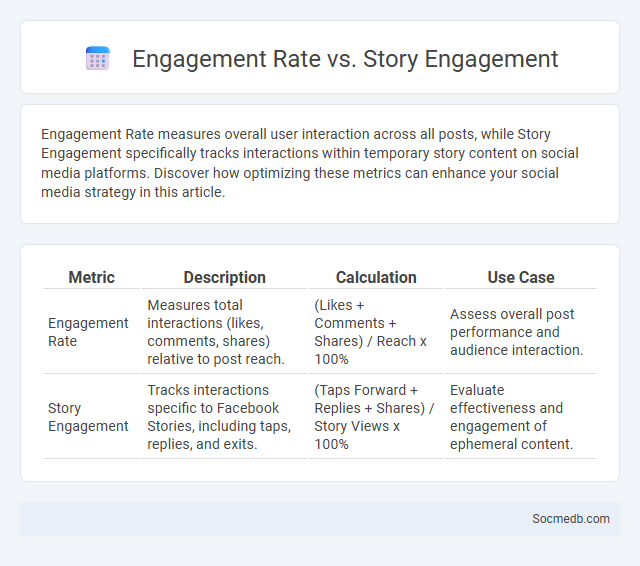
Photo illustration: Engagement Rate vs Story Engagement
Engagement Rate measures overall user interaction across all posts, while Story Engagement specifically tracks interactions within temporary story content on social media platforms. Discover how optimizing these metrics can enhance your social media strategy in this article.
Table of Comparison
| Metric | Description | Calculation | Use Case |
|---|---|---|---|
| Engagement Rate | Measures total interactions (likes, comments, shares) relative to post reach. | (Likes + Comments + Shares) / Reach x 100% | Assess overall post performance and audience interaction. |
| Story Engagement | Tracks interactions specific to Facebook Stories, including taps, replies, and exits. | (Taps Forward + Replies + Shares) / Story Views x 100% | Evaluate effectiveness and engagement of ephemeral content. |
Understanding Engagement Rate: Definition and Importance
Engagement rate measures the level of interaction your social media content receives relative to your follower count, including likes, comments, shares, and clicks. This metric is crucial for evaluating the effectiveness of your posts in capturing audience interest and driving meaningful interactions. Understanding engagement rate helps optimize your social media strategy to boost brand visibility and strengthen community connection.
What is Story Engagement? Key Metrics Explained
Story engagement refers to the interaction between your audience and the stories you share on social media platforms, measuring how viewers respond to your content. Key metrics include replies, shares, swipe-ups, sticker taps, and completion rates, providing insight into audience interest and behavior. Tracking these metrics helps you optimize your storytelling strategy to increase visibility and foster stronger connections with your followers.
Engagement Rate vs Story Engagement: Core Differences
Engagement Rate measures the overall interaction on your social media posts, including likes, comments, shares, and clicks, reflecting broad audience interest and content effectiveness. Story Engagement specifically tracks interactions with ephemeral content like Instagram or Facebook Stories, including taps, replies, and swipe-ups, offering insights into immediate, time-sensitive viewer behavior. Understanding these core differences helps you tailor strategies to boost either long-term post engagement or real-time story interactions effectively.
Why Engagement Rate Matters for Social Media Strategy
Engagement rate is a critical metric that measures how effectively your content resonates with your audience, driving meaningful interactions such as likes, comments, and shares. Higher engagement rates signal strong audience interest and can boost your content's visibility through social media algorithms, increasing organic reach. Understanding and optimizing this rate helps you tailor your social media strategy to build a loyal community and achieve measurable business outcomes.
Measuring Story Engagement: Methods and Tools
Measuring story engagement on social media involves analyzing metrics such as view duration, swipe-ups, replies, and shares to determine audience interaction. Tools like Instagram Insights, Facebook Analytics, and third-party platforms such as Hootsuite or Sprout Social provide detailed data on story performance, including reach, impressions, and engagement rates. Leveraging these methods allows marketers to optimize content strategies by understanding which story elements resonate most effectively with their audience.
Comparing Engagement Rate and Story Engagement Metrics
Engagement rate measures the overall interaction percentage a post receives relative to its audience size, highlighting likes, comments, and shares. Story engagement metrics specifically track how users interact with ephemeral content, including taps forward, backward, exits, and replies. Comparing these metrics reveals differences in user behavior and content effectiveness between permanent posts and temporary stories on platforms like Instagram and Facebook.
Common Mistakes When Evaluating Engagement Metrics
Misinterpreting engagement metrics like likes, comments, and shares can lead your social media strategy astray by overvaluing superficial interactions instead of meaningful audience involvement. Failing to consider the context of each metric or ignoring the quality of engagement often results in skewed analysis and ineffective content adjustments. Understanding the difference between reach, impressions, and genuine engagement ensures you optimize your efforts for stronger community connections and business growth.
Boosting Engagement Rate: Proven Tactics
Boosting your social media engagement rate relies on proven tactics such as utilizing eye-catching visuals, crafting compelling captions, and encouraging interactive content like polls and Q&A sessions. Incorporating consistent posting schedules combined with targeted hashtag strategies boosts visibility and interaction across platforms. Monitoring analytics allows you to refine content based on audience preferences, ensuring sustained growth and engagement.
Improving Story Engagement: Actionable Tips
Boost story engagement on social media by incorporating interactive features such as polls, quizzes, and question stickers that encourage audience participation. Utilize visually appealing elements like vibrant images, concise text, and engaging animations to capture attention quickly. Post consistently during peak hours based on your audience's online activity for maximum visibility and interaction.
Choosing the Right Metric: Engagement Rate or Story Engagement?
Choosing the right social media metric depends on campaign goals; engagement rate offers a comprehensive view of overall audience interaction through likes, comments, and shares, while story engagement specifically measures user interactions such as replies and swipe-ups on ephemeral content. Brands aiming to assess the effectiveness of interactive stories should prioritize story engagement metrics to capture real-time user behavior and preferences. Analyzing these metrics in alignment with platform-specific algorithms on Instagram, Facebook, or TikTok ensures optimized content strategies and improved audience targeting.
 socmedb.com
socmedb.com